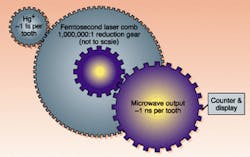All-optical atomic clock may be world's most precise
An all-optical atomic clock, recently demonstrated by researchers at the US National Institute of Standards and Technology (NIST; Gaithersburg, MD), produces about 1 quadrillion "ticks" per second and promises to be as much as 1000 times more accurate than the world's current standard in time measurement-cesium-based microwave atomic clocks.
"Our optical clock, as well as those being developed by other groups around the world, should give scientists an even finer-grained view of the physical world, much as precision spectroscopy in the past 50 years has opened the door to an improved understanding of many fundamental aspects of atoms and molecules," says NIST physicist Scott Diddams.
For the past 50 years, microwave atomic clocks have set standards for precision time and frequency metrology. Today, the most precise clocks are based on a natural atomic resonance of the cesium atom—the atomic equivalent of a pendulum. For example, NIST-F1, one of the world's most accurate time standards based on microwave atomic clocks, neither gains nor loses a second in 20 million years. The new clock, however, is designed to neither gain nor lose a second in 3 billion years.
The optical clock at NIST relies on a combination of advances in physics: the trapping and cooling of atoms and ions with lasers; frequency-stabilized lasers; and a new optical frequency "comb" that uses a femtosecond laser with nonlinear optical fibers to provide a simple, direct, and exact linkage between microwave and optical frequencies.
The researchers built their optical clock with a stable continuous-wave (CW) laser oscillator that is frequency doubled and locked to a narrow ultraviolet (282-nm) transition of a single, trapped and laser-cooled mercury ion (Hg+). Once stabilized, the frequency of the laser light was coherently divided down to lower frequencies with a femtosecond mode-locked laser that ultimately produced an electronic output at a frequency of 1 GHz. The envelope of the pulse train was made synchronous with the optical phase of the CW laser with approximately 532,361 optical cycles between pulses, which provides the "clock ticks" that are coherently connected to the Hg+ transition.
By comparison to a laser-cooled calcium optical standard, an upper limit for the fractional frequency instability of 7 x 10-15 was measured in 1 s of averaging—a value substantially better than that of the world's best microwave atomic clocks. A higher transition frequency can produce a more stable frequency standard. This is the primary advantage of an optical atomic clock over a microwave clock, as the operating frequency is 100,000 times higher—providing a finer division of time and thus potentially higher precision.
"From a technological standpoint, there is little dispute that stable and accurate microwave atomic clocks have greatly improved navigation and communications," Diddams says. "It is likely that optical clocks of the future will have a similarly important impact. Of particular interest will be the continued application of optical frequency standards in spectroscopy and the improved determination of the fine structure constant and the Rydberg constant. As measurement accuracy improves, metrologists may find themselves in the unique position of being able to observe physical 'constants' evolve in time."
REFERENCE
- S. A. Diddams et al., Science Express (July 12, 2001).

Sally Cole Johnson | Editor in Chief
Sally Cole Johnson, Laser Focus World’s editor in chief, is a science and technology journalist who specializes in physics and semiconductors. She wrote for the American Institute of Physics for more than 15 years, complexity for the Santa Fe Institute, and theoretical physics and neuroscience for the Kavli Foundation.
